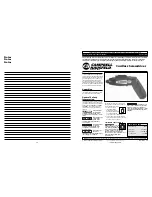
36
b) Screwing
After reaching the preset torque, the device's torque limiting mechanism starts to "rattle". This process
should not last longer than 1-2 seconds.
• The working procedure is divided into two steps: Screwing and tightening (torque limiting mechanism enabled). The
torque limiting mechanism is activated as soon as the screwed connection is tight and load is put on the motor (the
power of the motor is limited by the "rattling").
• Only place the power tool on the screw or nut when the tool is switched off. Rotating insertion tools can slip off and
damage the screw or nut.
• During use, start with a slow rotation speed and increase it in the course of work if needed. The rotation speed can
be controlled by pressing the on/off switch with varying pressure.
• It is recommended to perform the first few turns manually by hand with a wrench or screwdriver to ensure that the
thread screws in correctly.
• Do not apply too much pressure when screwing. This may damage the thread.
• Before screwing larger/longer wood screws, it is advisable to predrill a pilot hole with the core diameter of the thread
to approx. 2/3 of the given screw length.
• Always hold the drill perpendicular to the screw. Holding it at an angle may cause slipping or jamming of the bit.
11. Troubleshooting
1
No function, the appliance does not switch on.
• The battery is depleted. Charge the battery using the corresponding charger.
• The battery is not correctly inserted into the battery compartment (8) on the appliance.
• The screw is too tight or the drill has jammed. This causes the motor to overload when it starts up and switches it
off. Loosen the screw by hand slightly or remove the drill from the workpiece.
• The motor is overheated. Allow the device to cool down.
2
Drilling performance is poor.
• The drill bit is blunt and must be replaced or reground.
• The drill bit is not suitable for the processed material.
3
Abnormal vibrations occur.
• The quick-action chuck (1) is not tightened properly.
• The drill or screwdriver bit is bent.









































